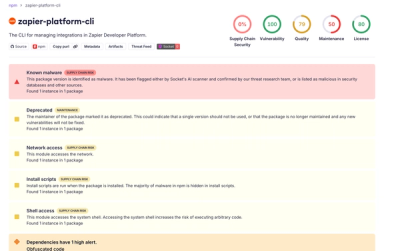@embroider/macros
A standardized solution for modifying your package's Javascript and Glimmer templates at app-compilation-time.
Motivation
Traditionally, Ember addons have a lot of power to run arbitrary code during the build process. This lets them do whatever they need to do, but it also makes them hard to statically analyze and makes them play badly with some tooling (like IDEs).
The Embroider package spec proposes fixing this by making Ember addons much more static. But they will still need the ability to change themselves in certain ways at app compilation time. Hence this package.
This package works in both Embroider and Classical builds, so that addon authors can switch to this newer pattern without disruption.
Setting Configuration: from a babel config
- Add
@embroider/macros as devDependency.
- In your babel config, do:
const { buildMacros } = require('@embroider/macros/babel');
const macros = buildMacros({
setOwnConfig: {
},
setConfig: {
'some-dependency': {
},
},
});
module.exports = {
plugins: [
[
"babel-plugin-ember-template-compilation",
{
compilerPath: "ember-source/dist/ember-template-compiler.js",
transforms: [...macros.templateMacros],
},
],
...macros.babelMacros,
],
};
Setting Configuration: from an Ember app
- Add
@embroider/macros as devDependency.
- In
ember-cli-build.js, do:
let app = new EmberApp(defaults, {
'@embroider/macros': {
setOwnConfig: {
},
setConfig: {
'some-dependency': {
},
},
},
});
Setting Configuration: from an Ember Addon
- Add
@embroider/macros as dependency.
- In
index.js, do:
module.exports = {
name: require('./package').name,
options: {
'@embroider/macros': {
setOwnConfig: {
},
setConfig: {
'some-dependency': {
},
},
},
},
};
The Macros
macroCondition
The macroCondition macro allows branch level code isolation (and deletion in the case of production builds). Generally macroConditions are viewed as a foundation macro and are combined with other macros (detailed below) to create more complex scenarios. macroCondition takes a single argument which must be statically known or another macro which will compile down to a static value.
import { macroCondition } from '@embroider/macros';
if (macroCondition(true)) {
} else if (macroCondition(false)) {
}
let specialVariable = 'Hello ' + (macroCondition(true) ? 'Bob' : 'Jane');
console.log(specialVariable);
Macros can also be used inside of templates:
{{#if (macroCondition true)}}
red
{{else}}
blue
{{/if}}
Starting with Ember 3.25 you can also use it to conditionally apply modifiers:
<button {{(if (macroCondition true) on) "click" this.something}}>Submit</button>
However, in all cases the argument to macroCondition must be statically analyzable:
import { macroCondition } from '@embroider/macros';
let foo = true;
if (macroCondition(foo)) {
}
importSync
The primary reason for Embroider's existence is to create statically analyzable builds. An under pinning of this
is the ability to walk and understand the dependency graph of every module. Embroider can natively understand imports such as import foo as 'foo' but cannot handle require's (imagine: require(bar ? 'bar' : 'baz'). The importSync macro is way to "tell" Embroider about the existence of a module and to bring it into a package's scope such that it can be discovered and included into the final build. importSync takes a single static string as its only required argument.
import { importSync } from '@embroider/macros';
let foo = importSync('foo');
let foo = require('foo');
hint
When using importSync on non ember-addon packages both the package being imported from and ember-auto-import must be in the dependencies of your addons package.json.
dependencySatisfies
Tests whether a given dependency is present and satisfies the given semver range. Both arguments must be strings and the second argument will be passed into semver's satisfies method.
import { dependencySatisfies } from '@embroider/macros';
let doesFooExist = dependencySatisfies('foo', '1.0.0');
let doesFooExist = true;
We can use this macro along with the macroCondition and importSync macro's from above to do something more complex:
import { macroCondition, dependencySatisfies, importSync } from '@embroider/macros';
if (macroCondition(dependencySatisfies('ember-qunit', '*'))) {
return importSync('ember-qunit');
} else if (macroCondition(dependencySatisfies('ember-mocha', '*'))) {
return importSync('ember-mocha');
}
{{macroDependencySatisfies 'qunit' '^2.8.0'}}
getOwnConfig, getConfig, and getGlobalConfig
A common pattern is to have a set of configuration properties that you define (or a consumer defines for you) which you base certain build time conditions around. This is achieved via the getOwnConfig, getConfig, and getGlobalConfig macros (depending on which config you want to read).
module.exports = {
name: require('./package').name,
options: {
'@embroider/macros': {
setOwnConfig: {
themeColor: 'red',
},
},
},
included() {
this._super.included.apply(this, arguments);
this.options['@embroider/macros'].setOwnConfig.shouldIncludeMinifiedLibrary = false;
},
};
import { getOwnConfig, importSync, macroCondition } from '@embroider/macros';
if (macroCondition(getOwnConfig().shouldIncludeMinifiedLibrary)) {
importSync('minified-library');
} else {
importSync('unminified-library');
}
<button class="{{macroGetOwnConfig "themeColor"}}">My Themed Button</button>
isTesting, isDevelopingApp
These methods can be used in conjunction with macroCondition to tree-shake code for specific environments.
import { isTesting, isDevelopingApp, macroCondition } from '@embroider/macros';
if (macroCondition(isTesting())) {
} else {
}
if (macroCondition(isDevelopingApp())) {
} else {
}
Note that these can be used in combination - e.g. if you run tests in the production environment, isTesting() will be true, but isDevelopingApp() will be false.
Glint usage
If you are using Glint and environment-ember-loose, you can add all the macros to your app at once by adding
import type { EmbroiderMacrosRegistry } from "@embroider/macros";
to your app's e.g. types/glint.d.ts file, and making sure your registry extends from EmbroiderMacrosRegistry:
declare module '@glint/environment-ember-loose/registry' {
export default interface Registry
extends EmbroiderMacrosRegistry {
}
}
Real world examples
Below are a list of addons that have started using @embroider/macros so that you can get a feel for common use cases that can be solved via the macro system.



